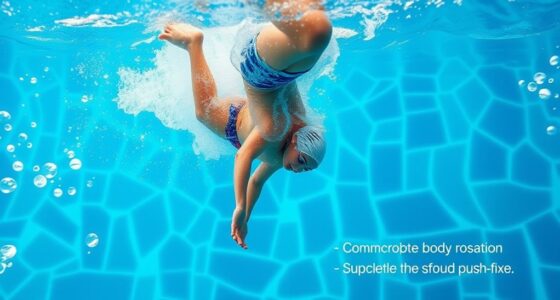To instantly boost your freestyle efficiency, focus on drills like bilateral breathing to keep your stroke balanced and smooth, and use body positioning exercises to maintain a streamlined, horizontal form. Engage your core to prevent hips from sagging and reduce drag. Incorporate slow, deliberate practice to improve technique and gradually increase speed while maintaining breathing rhythm and alignment. Keep perfecting these fundamentals, and you’ll discover even more ways to swim better with each session.
Key Takeaways
- Practice bilateral breathing every three strokes to promote symmetry and reduce water resistance.
- Incorporate catch-up drills to improve body alignment and develop smooth, efficient arm movement.
- Focus on maintaining a streamlined body position with high hips and engaged core muscles.
- Use slow, deliberate swimming to refine technique before gradually increasing speed.
- Continuously visualize a straight line from head to toes to enhance posture and reduce drag.

Freestyle swimming drills are essential for improving your technique, speed, and efficiency in the water. One of the most impactful ways to enhance your performance is by focusing on your breathing techniques and body positioning. When you master controlled breathing, you conserve energy, stay relaxed, and maintain a steady rhythm. Proper body positioning, on the other hand, guarantees you slice through the water with minimal resistance, making every stroke more effective.
Start by practicing bilateral breathing, which involves inhaling every three strokes instead of every two or four. This drill helps you develop a balanced breathing pattern, reducing asymmetry and promoting smoother, more efficient strokes. When you breathe, turn your head just enough to take in air without lifting it excessively, which can disrupt your body position. Keep your eyes looking down and slightly forward, maintaining a straight, aligned body. This minimizes drag and helps you glide through the water effortlessly.
Practice bilateral breathing for balanced, efficient strokes; keep your head steady and body aligned to minimize drag.
Focus on body positioning by working on your core stability and streamlined posture. Engage your abs and glutes to keep your hips high in the water, preventing your legs from sinking. A horizontal body position reduces water resistance, so you should aim to keep your body as flat as possible on the water’s surface. Visualize a straight line running from your head to your toes, and constantly adjust your posture to stay aligned. This alignment not only improves speed but also reduces fatigue, allowing you to swim longer and more comfortably.
Incorporate drills like the “catch-up” stroke, where one arm remains extended while the other completes a stroke, emphasizing a smooth, continuous motion. During this drill, pay close attention to your body position and breathing rhythm. Make sure your head remains in a neutral position and your body stays aligned, avoiding unnecessary yaw or hips sagging. As you switch arms, breathe in a controlled manner, coordinating your inhalation with your arm movement to avoid disrupting your streamlined posture.
Another effective drill involves focusing solely on your breathing and body position. Swim slowly, concentrating on inhaling smoothly and exhaling steadily through your nose or mouth. Keep your hips high and your body aligned, feeling how these elements work together to reduce drag. By incorporating proper technique, you can significantly improve your efficiency in the water. As you become more comfortable, increase your speed gradually, always maintaining your breathing rhythm and body alignment. Over time, these drills will become second nature, translating into more efficient strokes, improved endurance, and faster times in the water.
Frequently Asked Questions
How Often Should I Incorporate Drills Into My Training?
You should incorporate drills into your training about 2-3 times a week to balance skill work and endurance. Maintaining consistent drill practice helps improve efficiency without overtraining. Focus on quality over quantity, ensuring you’re attentive during each session. Adjust your training frequency based on your progress and how your body responds. Consistent drill work, combined with regular swimming, will help you enhance your technique and overall swimming performance effectively.
Can Beginners Benefit From These Freestyle Drills Immediately?
You might wonder if beginners can benefit from freestyle drills immediately. The answer is yes, but with a proper drill progression and a focus on technique, you’ll see faster improvements. Starting with basic drills emphasizes fundamental skills, helping you develop good habits early. Consistently practicing with attention to technique focus guarantees you refine your form gradually, making the drills more effective and your swimming more efficient over time.
What Equipment Is Necessary for Effective Drills?
Imagine you’re a modern swimmer, not a medieval knight—what equipment do you need? For effective drills, you’ll want swimming goggles to keep your eyes clear and a pull buoy to focus on your arm technique. These essentials help you maximize efficiency and control. No fancy gear is required; just these basics, and you’re set to enhance your form and speed in the pool.
How Do I Measure My Improvement in Efficiency?
To measure your improvement in efficiency, focus on drill progression and efficiency metrics. Track your times over consistent distances, noting reductions as signs of progress. Use tools like a stopwatch or a swim watch to monitor your pace and stroke count. Pay attention to how smoothly you move through the water, aiming for better glide and less drag. Regularly assess these metrics to see how your technique evolves with practice.
Are There Specific Drills for Different Skill Levels?
Imagine opening your full potential—yes, each drill is a key. For different skill levels, you should follow a drill progression that challenges yet matches your ability. Beginners focus on basic technique, while advanced swimmers incorporate complex drills for skill adaptation. These tailored drills help you grow steadily, making improvements feel natural and rewarding. Remember, consistency in progression transforms effort into effortless efficiency in your swim.
Conclusion
By incorporating these freestyle swimming drills into your routine, you’ll find your technique gradually blossoming, making every stroke feel more effortless and graceful. Remember, progress often comes gently, like a soft breeze guiding you forward. Embrace each small improvement with patience and a smile, knowing that your skills are quietly transforming beneath the surface. With consistent practice, you’ll enjoy swimming more than ever, discovering a smoother, more enjoyable rhythm that makes every lap a delight.










